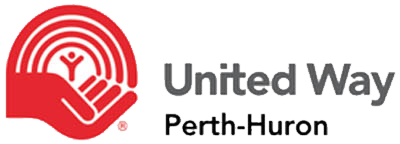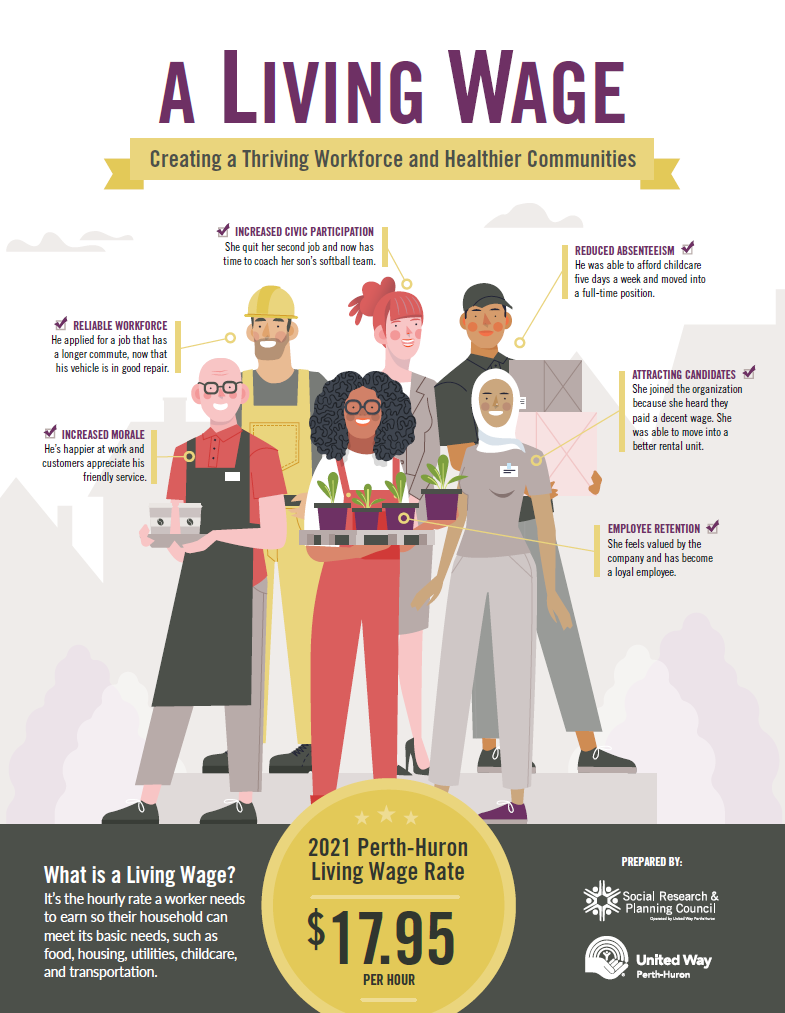The Social Research and Planning Council
The Social Research and Planning Council (SRPC) is operated by United Way Perth-Huron and is comprised of community representatives who are dedicated to the collection, analysis and distribution of information relating to social trends and issues in Perth and Huron County. Research enables United Way to discover and understand the root causes of issues affecting Perth-Huron and in turn mobilize the community. The SRPC is also a member of the Social Planning Network of Ontario.
Social Planning Councils share the role of tracking the community pulse, providing a public forum for social issues, identifying and prioritizing unmet needs and building community commitment and capacity to address these needs. The SRPC produces reports for the community and wants to know what information is beneficial for you, your family and the community. Please email any feedback and comments to: srpc@perthhuron.unitedway.ca.
Our Reports
Quality of Life in Perth-Huron
Introduction
Welcome to Quality of Life in Perth & Huron County 2023: a series of reports providing a holistic look at quality of life in Perth and Huron Counties. We present findings we can celebrate and issues we can work on. We hope these reports will act as catalysts for community discussions and collaborations and help leaders — elected and otherwise — make informed policy and funding decisions.
Quality of life refers to the general well-being of individuals and society defined in terms of health and happiness, rather than wealth. Purely economic indicators like Gross Domestic Product are not sufficient to measure well-being. A broad range of factors play into quality of life. This report looks at the subject from many angles.
The data in this report is drawn from a wide variety of local, provincial and national sources, each with varying scope and applicability. Some accurately reflect the whole population, while others may only reflect part of the population. It is also possible that errors or omissions have been made. Additionally, the COVID-19 pandemic seriously disrupted all types of organizations, often affecting their ability to collect consistent data. With this in mind, we should exercise caution as we interpret and analyze this data and we should hesitate to draw firm conclusions.
Quality of Life: Executive Summary

This series of reports provides a holistic look at quality of life in Perth and Huron Counties. We present findings we can celebrate and issues we can work on. We hope these reports will act as catalysts for community discussions and collaborations and help leaders—elected and otherwise—make informed policy and funding decisions.
This summary includes information and recommendations from the other five reports: Who We Are, A Strong Economy, A Diverse Community, A Clean Environment, and A Healthy Well-Being.
Executive Summary (Online Magazine) Executive Summary (PDF)
Quality of Life: Who We Are

This report provides demographic statistics from the most recent Census of Canada (2021) and a few estimators from Environics Analytics. Understanding the demographics of a community is like having a roadmap to meet unique needs.
Who We Are provides crucial information about the people who make up the Perth and Huron region. Knowledge and understanding of details such as age, gender, family composition, and geography help tailor services and programs that resonate with the community’s specific needs.
Who We Are (Online Magazine) Who We Are (PDF)
Quality of Life: A Strong Economy

Economic factors have a critical impact on quality of life. Employment is a significant contributor to overall quality of life. Together, income, financial security and employment directly impact one’s ability to afford essentials such as adequate housing, food, energy, internet and transportation. Emotional, physical and mental well-being is connected to access to these critical rights and factors.
While low income is an indicator of living in poverty, it is not the same thing. Poverty is complex provide various indicators that contribute to having enough money or access to resources to enjoy a decent standard of living.
Our Strong Economy provides recommendations for community organizations and different levels of government to engage in positive actions to improve our economic well-being.
A Strong Economy (Online Magazine) A Strong Economy (PDF)
Quality of Life: A Diverse Community

A community can be diverse in many ways. It might be home to people from a range of ethnic, racial and cultural backgrounds. Community members may have different lifestyles, interests, values and experiences. Encouraging and maintaining a diverse community involves appreciating and respecting the ways people can be different from one another.
It is important to consider the interconnected nature of elements of diversity such as race, gender, age, ethnicity, socioeconomic status, culture, and varied abilities. How our systems reflect and value diversity is important for the quality of life of our community.
A Diverse Community offers recommendations for individuals, businesses, organizations and all levels of government to harness the advantage of the diversity in our community.
A Diverse Community (Online Magazine) A Diverse Community (PDF)
Quality of Life: A Clean Environment
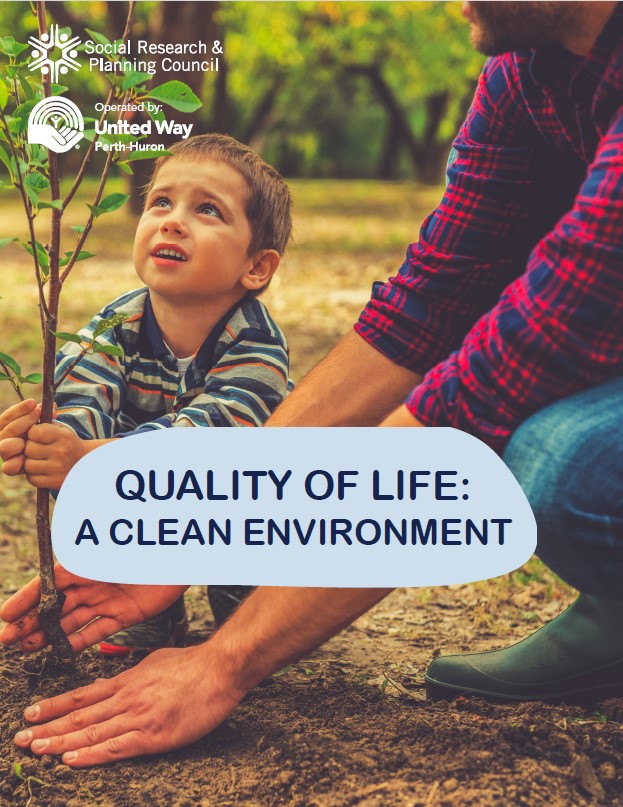
The environment around us is key to our existence. Our forests, rivers, lakes and soil provide us with the food we eat, the water we drink and the air we breathe. Our health and prosperity rely on the natural world and we must keep it healthy to survive. For Indigenous peoples, their relationship with the land is spiritual, whereas the Western worldview largely sees the land and its resources as commodities to develop and extract for the benefit of humans. In our region, there are reasons to be concerned about the environment, from a rise in Special Air Quality Statements to the state of our forests and wetlands.
A Clean Environment (Online Magazine) A Clean Environment (PDF)
Quality of Life: A Healthy Well-Being

Our physical and mental health and the quality of our social environment all play into our quality of life. As social creatures, we are intimately affected by our social ties. Factors including the safety of our neighbourhoods, community connections, the quality of our schools and the representativeness of our governments all work to determine our well-being.
This report also describes factors contributing to individual health, such as adequate income, meaningful work, decent housing and healthy food. Shifting these conditions requires collective action across society to create equitable communities and policies enabling everyone to enjoy health and well-being.
A Healthy Well-Being (Online Magazine) A Healthy Well-Being (PDF)
Municipal Accommodation Tax – White Paper
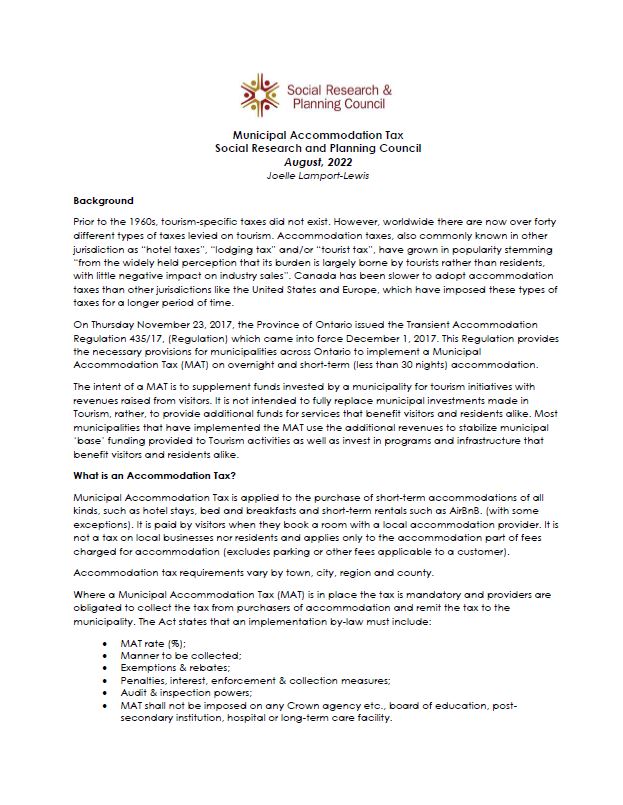
PDF: Municipal Accommodation Tax
Prior to the 1960s, tourism-specific taxes did not exist. However, worldwide there are now over forty different types of taxes levied on tourism. Accommodation taxes, also commonly known in other jurisdiction as “hotel taxes”, “lodging tax” and/or “tourist tax”, have grown in popularity stemming “from the widely held perception that its burden is largely borne by tourists rather than residents, with little negative impact on industry sales”. Canada has been slower to adopt accommodation taxes than other jurisdictions like the United States and Europe, which have imposed these types of taxes for a longer period of time.
On Thursday November 23, 2017, the Province of Ontario issued the Transient Accommodation Regulation 435/17, (Regulation) which came into force December 1, 2017. This Regulation provides the necessary provisions for municipalities across Ontario to implement a Municipal Accommodation Tax (MAT) on overnight and short-term (less than 30 nights) accommodation.
The intent of a MAT is to supplement funds invested by a municipality for tourism initiatives with revenues raised from visitors. It is not intended to fully replace municipal investments made in Tourism, rather, to provide additional funds for services that benefit visitors and residents alike. Most municipalities that have implemented the MAT use the additional revenues to stabilize municipal ‘base’ funding provided to Tourism activities as well as invest in programs and infrastructure that benefit visitors and residents alike.
Household Food Insecurity – Perth-Huron
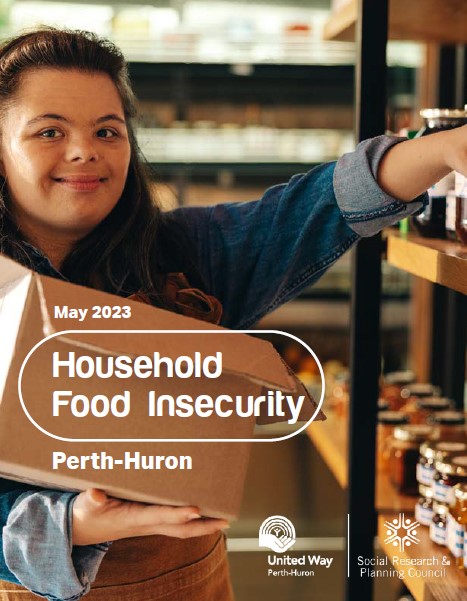
PDF: Household Food Insecurity
Read online: Household Food Insecurity
In November 2022, United Way Perth-Huron’s Social Research & Planning Council designed and implemented a survey to capture the characteristics of food insecurity in Perth County and Huron County, including the municipalities of Stratford and St. Marys. Our goal was to understand the nature and severity of household food insecurity regionally. Specifically, we hoped to investigate food insecurity caused by financial constraints.
We began by noting the 2021 Census showed that 14,320 individuals in Perth and Huron live with low income based on the Low-income measure, after tax (LIM-AT). With this number in mind, we set a target of a 500-person sample size to produce a 5% margin of error (meaning the results might be 5% less or greater than the reality).
Thanks to exhaustive promotion and community efforts, 1,125 surveys in both paper and digital formats were collected and 63% met the inclusion criteria. This report outlines key findings from the analysis of 711 responses from this survey.
*Please note that findings only discuss the portion of our population experiencing food insecurity, not the population as a whole.
Progressing Beyond Covid
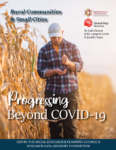
Read online: Progressing Beyond Covid
In the spring of 2022, the Research and Data Advisory Consortium through the Social Research and Planning Council reviewed the past three years of the realities faced by small/rural communities during the COVID-19 pandemic. After further exploration of experiences, and a focus on the causes of these disruptions, it is imperative that local opportunities for progress are recognized and there is a shift toward looking at a future state.
A panel — including, Mike Moffat, Canadian Economist and Professor of International Trade, Eddie Matthews, Stratford and District Chamber of Commerce, as well as Ellen Sinclair and Danielle Letang from the Rural Ontario Institute — spoke to these realities. The panel offered insights into how small/rural communities have an unprecedented chance to thrive in a post-COVID Canada.
The Future of Housing
 Read a downloadable PDF: Future of Housing
Read a downloadable PDF: Future of Housing
Read online as magazine: Future of Housing
In one year, the average price for a detached home in Perth and Huron Counties increased over 35% to $549,000. At the same time, rent for a two-bedroom unit has increased by 18% to over $1,200 a month. Provision of adequate and attainable housing is one of the most critical issues facing our communities. This report presents a detailed overview of the housing crisis across Perth and Huron Counties. More specifically, by presenting recent data on market trends, population projections, income and workforce and an explanation of the changing expectations of the workforce, four actions are proposed: 1) Education Campaign, 2) Workforce Attraction & Retention 3) Collaboration, Consolidation and Clarity of Direction and 4) Potential BIG System Change. It is critical that all levels of government collaborate to tackle the housing crisis to ensure all residents from our communities have access to adequate and accessible housing.
Rural Response to COVID-19
Rural Response to COVID-19 is a project about gathering data regarding the experiences of residents from small towns and rural areas related to COVID-19. In order to ensure that response plans, policies, and programs are effective, it is critical that local data is used to inform decisions. Five reports were developed after data was collected.
Mental Health Across Perth-Huron (2021)
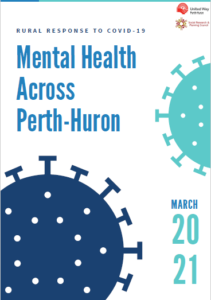 Download the full report (pdf) [13 pages]
Download the full report (pdf) [13 pages]
Download the Summay (pdf) [2 pages]
The World Health Organization declared COVID-19 a pandemic on March 11, 2020 advising all countries to implement a number of restrictions (e.g., social distancing) to curb the spread of the virus. Governments have instituted measures to contain the spread of COVID-19 including population-level containment strategies (e.g., quarantine, isolation, school and business closures).
While research has examined the impacts of COVID on individuals, economics and organizations, these have largely been focused on urban concerns. In Canada, approximately 20% of the population, or eight million people, reside in non-urban areas. It is critical that the experiences of rural Canadians are included in policy decisions.
Impacts Across Perth & Huron Counties
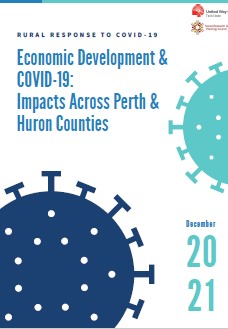 Download the full report (PDF)
Download the full report (PDF)
This report provides a snapshot of the economic development-related results. Economic Development is widely recognized as one the most important indicators of vulnerability and COVID-19 has disproportionately impacted certain cohorts within our community. Across small and rural communities, economic development has been identified a significant area of concern. In many instances, COVID-19 has exacerbated already inequitable economic development dynamics (e.g., income). To be able to respond and develop appropriate policies and programs, reliable and valid data must be collected. These results can be used to advocate for specific support services that currently are either ineffective or lacking altogether.
The Impacts on Gender Across Perth and Huron Counties
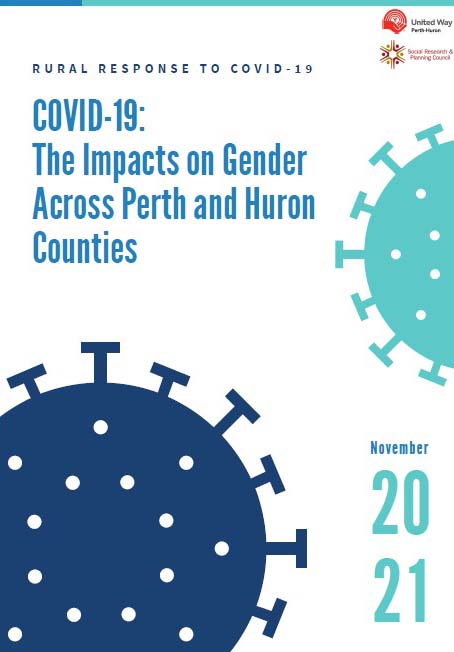 Download the full report (PDF)
Download the full report (PDF)
This report provides a snapshot of the gender-related results. Gender is widely recognized as one of the most important indicators of vulnerability and COVID-19 has disproportionately negatively impacted self-identifying females. Across small and rural communities, gender equality has been identified as a significant area of concern. In many instances, the pandemic has exacerbated already inequitable gender dynamics (e.g. income, anxiety levels).
Housing Across Perth & Huron Counties
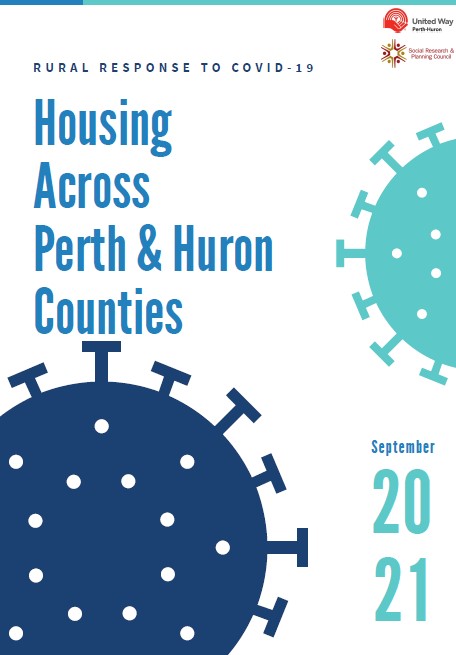 Download the full report (PDF)
Download the full report (PDF)
This report provides a snapshot of the housing-related results. Housing-related concerns have received a considerable amount of attention since the start of COVID-19. Secure housing is often indicative of increased resiliency and ability to respond to challenges. Across small and rural communities, housing needs have been identified as a significant area of concern. In many instances, COVID-19 has exacerbated already low housing stock, decreased housing affordability, and increased housing insecurity.
Homelessness in Perth County
 Perth Homelessness Presentation (PDF)
Perth Homelessness Presentation (PDF)
Find out more about the #UNIGNORABLE issue of homelessness in Perth County; reasons for homelessness, the challenges faced by those experiencing homelessness, myths vs. reality, the human impact of not earning enough, housing unaffordability and much more.
LEEP Survey: Housing & Homelessness
LEEP Survey: Housing & Homelessness
The Lived Experience Panel was asked questions on the topic of housing and homelessness. It was stated that there was more than just ‘one thing’ needed to fix the housing crisis. Most agreed that there is a serious shortage of quality affordable housing, more housing options are needed, specifically geared towards lower income individuals.
Supportive Housing (2021)
 Read full report online as magazine: Supportive Housing
Read full report online as magazine: Supportive Housing
Read summary of report online as magazine: Supportive Housing Summary
Download PDFs Supportive Housing Report – FULL | Supportive Housing – SUMMARY
Over the past decade federal, provincial and municipal governments across Canada have revitalized their focus on homelessness and housing attainability. Housing is critical in determining how all aspects of our lives are fulfilled. Canada’s first National Housing Strategy Act declares that the right to adequate housing is a fundamental human right affirmed in international law. It recognizes that adequate housing is essential to a person’s inherent dignity and well-being and to building healthy, sustainable communities for all.
This report is designed to help enhance an understanding of homelessness and the role supportive housing can play within a larger strategy to end chronic homelessness. It provides an overview of best practices being implemented to address chronic homelessness; references supportive housing strategies that help people with the most complex mental health and addiction needs to stabilize their housing; and offers strategic actions for consideration to support the Huron and Perth communities toward achieving their goals of eradicating chronic homelessness and supporting their most vulnerable citizens.
Forward Together: An integrated approach to Mental Health and Addictions in Huron Perth (2021)
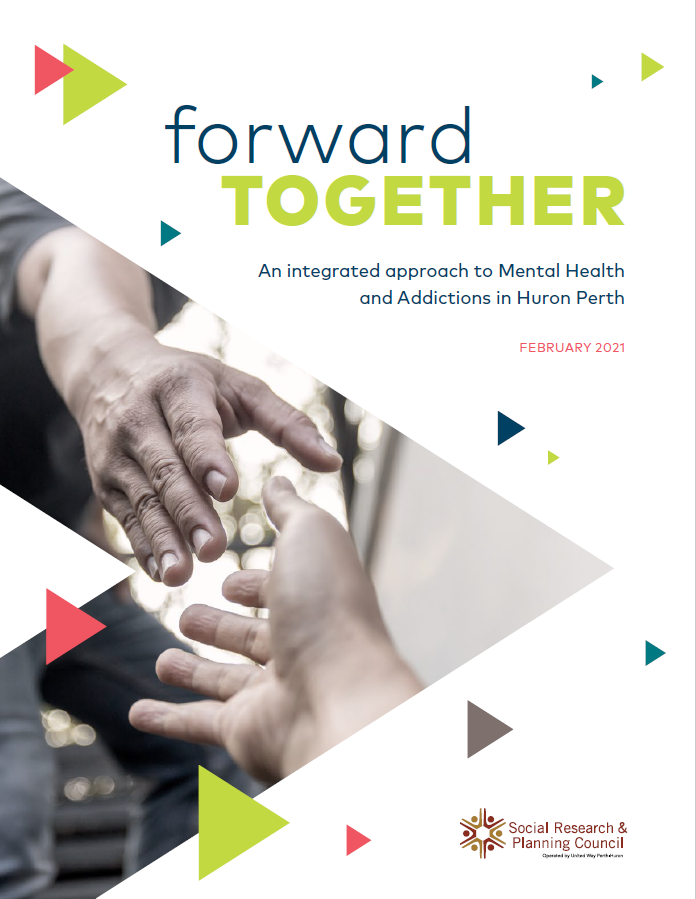 Download PDF: Forward Together Report PDF
Download PDF: Forward Together Report PDF
Read online as magazine: Forward Together
The COVID-19 pandemic is contributing to and magnifying mental health and addictions issues in Huron Perth. It is likely this impact will be serious and long-lasting, placing additional strains on a MH&A system where demand for care has dwarfed service capacity for years. The report aims to better understand the current mental health and addictions system in Huron Perth; inform community leaders about the achievements over the past eight years and collaborations underway to improve the system; identify outstanding challenges for Huron Perth residents; and review Ontario’s new Roadmap to Wellness: a plan to build Ontario’s mental health and addictions system.
For a list of some of the available mental health & addictions resources in Perth and Huron, GO HERE. For help navigating the network of human sources quickly and easily, please dial 211. 211 is a free service, available 24 hours a day, seven days a week, 365 days a year. A trained operator will listen to your challenges and find you the help you need in the community you live in.
Non-profit Response and Recovery Survey Summary (2021)
 Download the Survey Summary (pdf).
Download the Survey Summary (pdf).
The COVID-19 pandemic has had an impact on organizations across Perth and Huron Counties. The Social Research and Planning Council distributed a survey to area non-profits to determine the impact COVID-19 had on organizations, changes (if any) that were required and most pressing concerns among employees.
LEEP Survey Report: Basic Income
 What Do You Think Would Happen in Your Community If We Had Basic Income in Canada? (pdf)
What Do You Think Would Happen in Your Community If We Had Basic Income in Canada? (pdf)
A volunteer panel made of Huron County residents who have current or past involvement with social systems in Huron and Perth. The majority of participants said that reducing poverty and increasing income security would be the greatest impact in our community. This includes reducing stigma and increasing community participation.
A Living Wage
What it takes to make ends meet in Perth and Huron Counties (2021)
The concept of a Living Wage is bigger than income. It’s about quality of life. It’s about ensuring our neighbours can afford to pay their rent and buy nutritious food. It’s about ensuring our workers are healthy and able to pay for transportation to get to work every day. It’s about ensuring our children are given sufficient social and educational opportunities so they can flourish.
The calculation is based on the living expenses of a family of four in Perth Huron with both adults working full-time for 35 hours a week each, once government transfers and deductions have been taken into account. 2019’s Living Wage for Perth-Huron has been calculated at $17.55/hr.
How Much is Enough?
The Impact of Low Incomes on Households and Communities in Perth and Huron Counties (2019)
Read online as magazine How Much is Enough
Download the full report (PDF) | Download the Summary (PDF)
It’s a sobering statistic; 1 in 2 households in Perth and Huron Counties earn below the Living Wage level of $17.55/hr. Families working hard in minimum wage positions, or juggling 2 or 3 part time jobs, are forced to make hard decisions between paying rent and purchasing healthy food — and paying bills late if they can at all — creating constant stress. Shame, guilt and depression are common and the continuous, daily struggle to make ends meet creates an environment where it is hard to focus on anything other than survival. This can lead to a perpetual cycle of poverty, hurting individuals and deepening divisions within communities.
The How Much is Enough? report builds on previous research conducted in 2015 regarding the Living Wage in Perth-Huron. Focus groups were conducted in order to better understand the experiences of individuals earning below a Living Wage and employers that may want to pay, or do pay, a Living Wage.
A Living Wage
What it takes to make ends meet in Perth and Huron Counties (2018)
A Living Wage is the hourly wage a worker needs to earn to cover their family’s basic everyday expenses such as food, housing, utilities, childcare and transportation. It is voluntary, calculated based on local costs and adjusted regularly to take into account cost of living increases and changes to government transfers and deductions.
Earning a Living Wage encourages families to participate more fully in their communities, supports healthy child development and helps ensure families are not facing ongoing, severe financial distress. Not only workers benefit from earning a Living Wage. Employers find morale, productivity and loyalty all increase when workers are paid a Living Wage. Communities also benefit as employees who earn more are able to put more back in to the local economy, child poverty rates decrease and residents become more engaged.
Embracing Diversity
Newcomer experiences in Perth and Huron County (2017)
Download the Full Report (PDF) | Download the Community Summary (PDF) | Download the Employer Summary (PDF) 
Read online as magazine Embracing Diversity
In 2015, more than 75% of Canada’s new permanent residents landed in just seven cities; Toronto, Montreal, Vancouver, Calgary, Edmonton, Ottawa and Winnipeg. During the same year, only 5.8% of recent immigrants settled in rural areas while the remainder settled in other urban locales. This presents a challenging situation for rural communities that must not only offer ways to attract newcomers to their communities, but also ensure they stay.
SRPC’s Newcomer report looks at how newcomers are experiencing our community, the challenges they face in settling here and how we can help make our community a more welcoming place to live.
A Living Wage
What it takes to make ends meet in Perth and Huron Counties (2015)
Download the Living Wage Report (2015) (PDF) | Download the Living Wage Report summary (2015) (PDF) 
Research shows that a Living Wage helps improve the overall quality of life in a community. It helps lift children out of poverty by giving families a basic level of economic security, allowing them to live without the constant stress of deciding which bills to pay. Employers who pay a Living Wage report lower turnover and absenteeism rates, and greater employee engagement and loyalty. The additional money working families earn is spent in the local economy.
Quality of Life
The general well-being of individuals and the community of Perth and Huron Counties (2014)
Download the Quality of Life Report (2014) (PDF) | Download the Quality of Life Report summary (2014) (PDF) 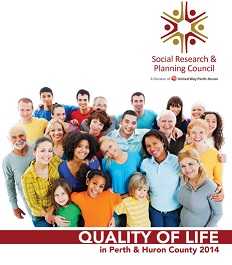
Read online as magazine Quality of Life
Quality of life refers to the general well-being of individuals and society and is defined in terms of health and happiness rather than wealth.
In many respects, quality of life is subjective. What is considered ‘good’ varies from individual-to-individual and community-to-community. In addition to common indicators such as education, work and health, it explores issues like how safe our community is, how engaged residents are in community life, how we treat the planet and how we spend our time.
The Quality of Life report has transitioned to an online information resource, found at myPerthHuron.ca.
The Heart of the Community
A Report of Volunteerism in Perth and Huron Counties (2013)
Download The Heart of the Community Report (2013) (PDF) 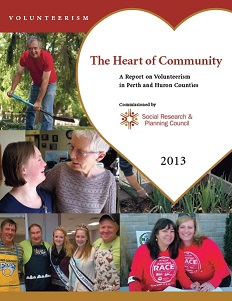
In Ontario, Canada and around the world volunteers are playing an increasingly important role in shaping the kinds of communities we live in. They connect people and causes and have an enormous impact on society, culture, the economy and their own health and well-being.
All across the country volunteers organize and work at events, raise funds, deliver meals and offer companionship to the sick and dying. They visit seniors, coach children’s sports, provide transportation and mentor their fellow Canadians.
Opening the Door
A Report on violence against women in Perth and Huron Counties (2013)
Download the Opening the Door – Violence Against Women Report (2013) (PDF) 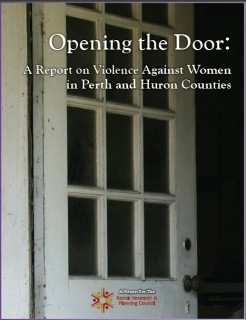
Violence against women represents a unique aspect of the wider social problem of violence, requiring special attention and a gendered analysis. Although men also experience violence, this study focuses on the experiences of women, recognizing the gendered nature of the violence they experience and its basis in the social conditions of gender inequality. Every year, violence in the home and the community devastates the lives of millions of women. In Ontario, less than a quarter of victims report the incident to police and many experience violence multiple times before they report it. In a 2009 Statistics Canada study on family violence in Canada, it was reported that more than 6% of Ontario women living in a common-law or marital relationship report experiencing physical or sexual assault by a partner.
Starting the Conversation
A report on substance abuse and problem gambling in Perth and Huron Counties (2012)
Download Starting The Conversation Report (2012) (PDF) 
Read online as magazine Starting the Conversation
Talking openly about addiction is not an easy thing. Recent public education campaigns promoting responsible gambling, encouraging parents to talk to their kids about drugs and reminding us of the dangers of drinking and driving have all helped break the silence about addiction in our society. But many myths and misunderstandings still exist; and the stigma and shame surrounding addiction continue to silence and isolate people in our communities who need support, help and understanding.
The Road Ahead
A study of transportation needs across Huron and Perth Counties (2012)
Download The Road Ahead Transportation Report (2012) (PDF) 
How do people manage without a car in Perth and Huron Counties? Extensive interviews and research show they face many difficulties, not only in travelling outside their own communities, but in the activities of everyday life. This is particularly true for those who are disadvantaged by reason of health, employment, or family circumstance. Rural residents worry that services may not be there when they need them. They are being asked to adapt to rapid changes that are often difficult to understand. This is particularly hard for those who face economic challenges, as many in rural Ontario do.
Breaking the Silence
A report on elder abuse in Perth County (2009)
Download Breaking the Silence – Report on Elder Abuse (2009) (PDF) 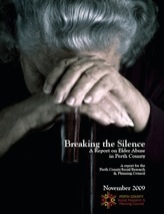
It’s estimated that between 4 and 10 per cent of Ontario seniors experience some type of abuse, and the estimates are no different for Perth County; if anything, the problem takes on even greater significance here since Perth has the highest per-capita ratio of seniors in the province.
The trouble is, like elsewhere in the country only a small number of elder abuse incidents are reported to local agencies and authorities. Clearly, the majority of offences here go either undetected or unreported — or both. That’s because victims are often ashamed, dependent on their abusers for care, afraid of
retaliation, abandonment or being institutionalized. Sometimes it’s because they don’t know who or where to turn to for help. More often, they’re simply unwilling or unable to report the abuse.
Facing the Future
The socio-economic impact of the global recession on Stratford, St.Marys and Perth County (2009)
Download Facing the Future – Socio Economic Impact Report (2009) (PDF) 
Imagine being told the factory where you’ve worked for over 20 years is closing – for good – and you’re soon going to be jobless. To make matters worse, your husband is also out of a job because he works there too.
Gone are the $75,000 annual family income and all the benefits you both took for granted for all those years. Just think – kids to support, a mortgage and no post-secondary education, in fact no high school diploma. What do you do? Where do you turn? How do you begin to start over?
What would you do if you lost your job at 58? Too young to retire, but too old to be considered a catch by another employer. And try and imagine going from a $24-an-hour job, to Employment Insurance benefits of $472 a week, which will eventually run out just like your savings. Still without a job, you’re forced to apply for social assistance, which means you’ve now got an even bigger challenge – how to live on just $572 a month.
These are the kinds of situations an increasing number of Perth County residents are facing as the impact of the global recession is absorbed locally.
It Affects Us All
A report on mental illness in Perth County (2008)
Download It Affects Us All – Mental Health Report (2008) (PDF) 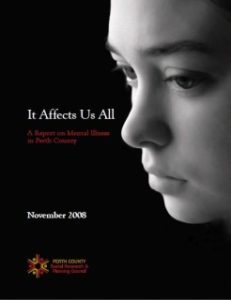
Read online as magazine It Affects Us All
What would you do if you discovered your 13-year old daughter intentionally cutting herself and threatening suicide? How about if your aging mother were falling victim to Alzheimer’s? And what if you were a productive, wage-earning member of the workforce one day and crippling depression made it hard for you to drag yourself out of bed the next?
Think it couldn’t happen to you?
The fact is, mental illness can strike anyone, at anytime. It doesn’t discriminate based on age, race, gender, occupation or socio-economic status. Everyone is a potential candidate but unless you — or someone you’re close to — has had a mental illness, you have no idea what it’s like or how devastating the consequences can be.
Quality of Life in Perth County
A 2008 Profile
Download Quality of Life – A 2008 Profile Report (2008) (PDF) 
Quality of life has been defined as “the product of the interplay among social, health, economic, and environmental conditions which affect human and social development”. Quality of life in any community is influenced by a variety of interrelated factors, such as the local economy, housing, education, environment, heath and personal safety. Because the experience of quality of life is personal, problems in a community may be hidden from many of the people who live there. If our circumstances are comfortable, it takes obvious, community-wide problems like air pollution, traffic jams or blackouts to register. Objective data is needed to inform citizens and policy makers of the true state of those factors that contribute to quality of life.
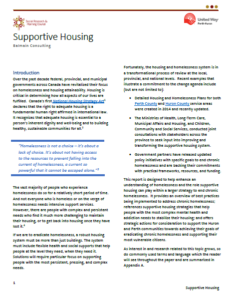 Supportive Housing
Supportive Housing
Vol1 Ed3 Quarterly Report – Supportive Housing PDF
This report is designed to help enhance an understanding of homelessness and the role supportive housing can play within a larger strategy to end chronic homelessness. It provides an overview of best practices being implemented to address chronic homelessness; references supportive housing strategies that help people with the most complex mental health and addiction needs to stabilize their housing; and offers strategic actions for consideration to support the Huron and Perth communities toward achieving their goals of eradicating chronic homelessness and supporting their most vulnerable citizens.
 Living Wage
Living Wage
Vol1 Ed1 Quarterly Report – Living Wage PDF
This report reviews the value of employers paying a Living Wage and the implications to consumers, the economy and the employee through the new realities of a minimum wage earner. The report also examines the benefits of reducing inequalities within a community by increasing consumer spending, productivity and employer success. Ultimately, paying a Living Wage is an investment in qualified, productive and committed employees often leading to an improved bottom line.

Basic Income
Vol1 Ed2 Quarterly Report – Basic Income PDF
Vol1 Ed 2 Booklet Summary – Basic Income PDF
A Basic Income is an unconditional cash transfer from government to individuals to enable everyone to meet their basic needs, participate in society and live with dignity, regardless of employment status.
Around the world, having a Basic Income is becoming recognized as a highly effective way to support important societal goals, including the reduction and elimination of poverty and economic insecurity; the narrowing of extreme income and wealth inequalities; improved health, democratic and economic functioning .
